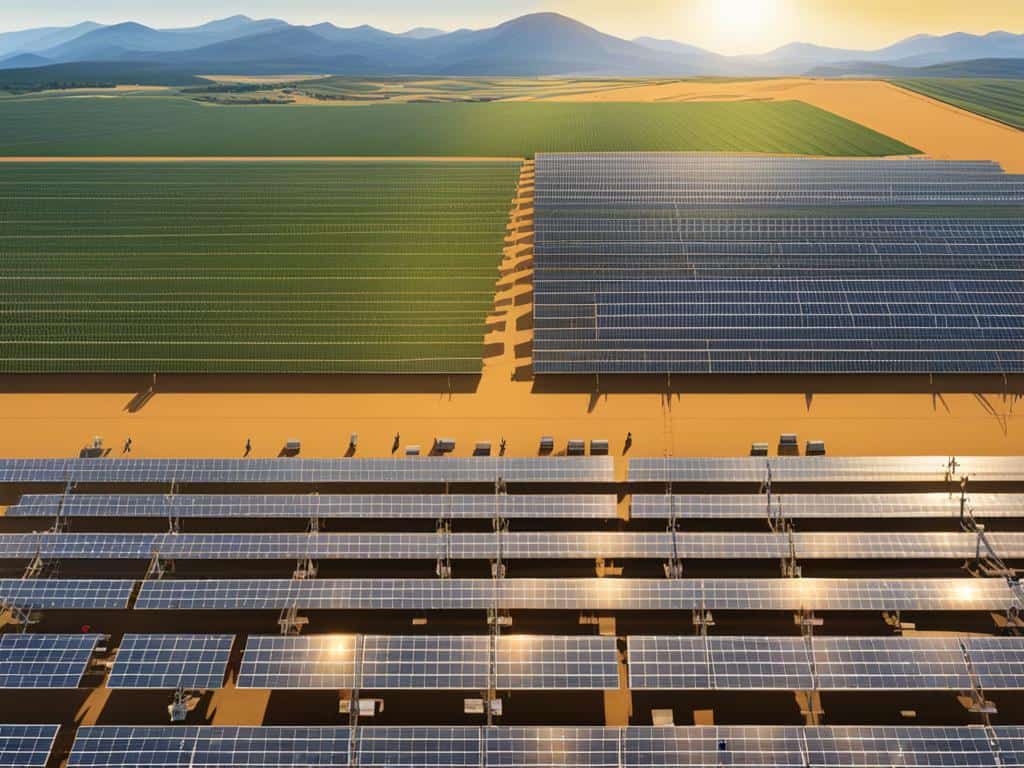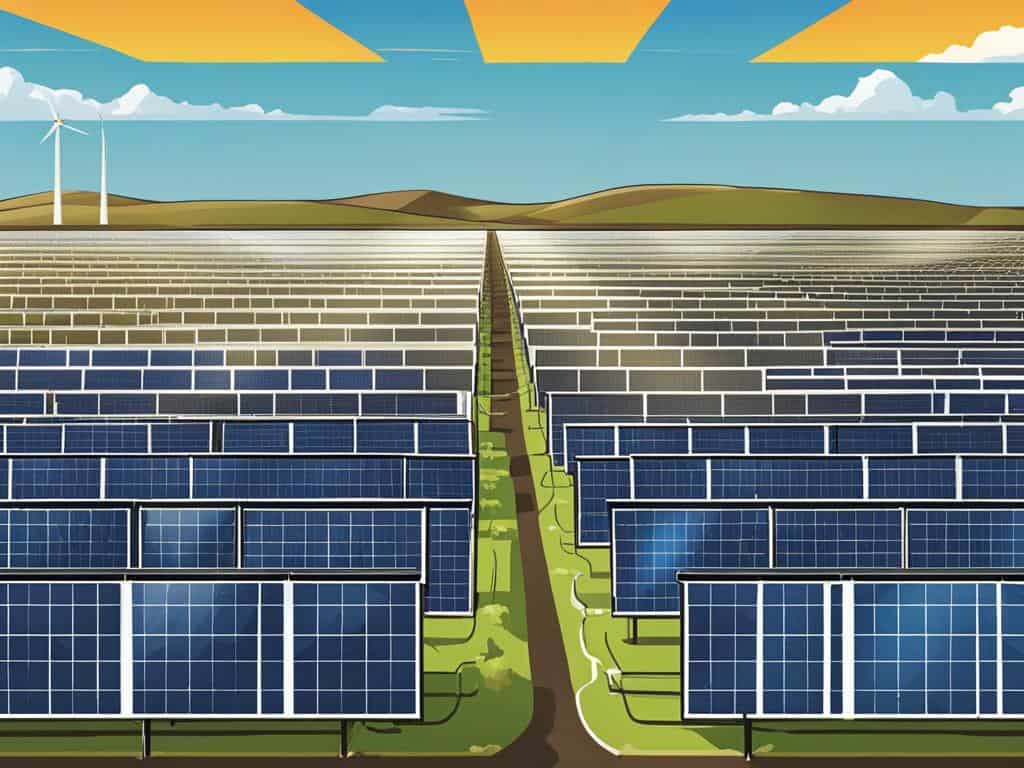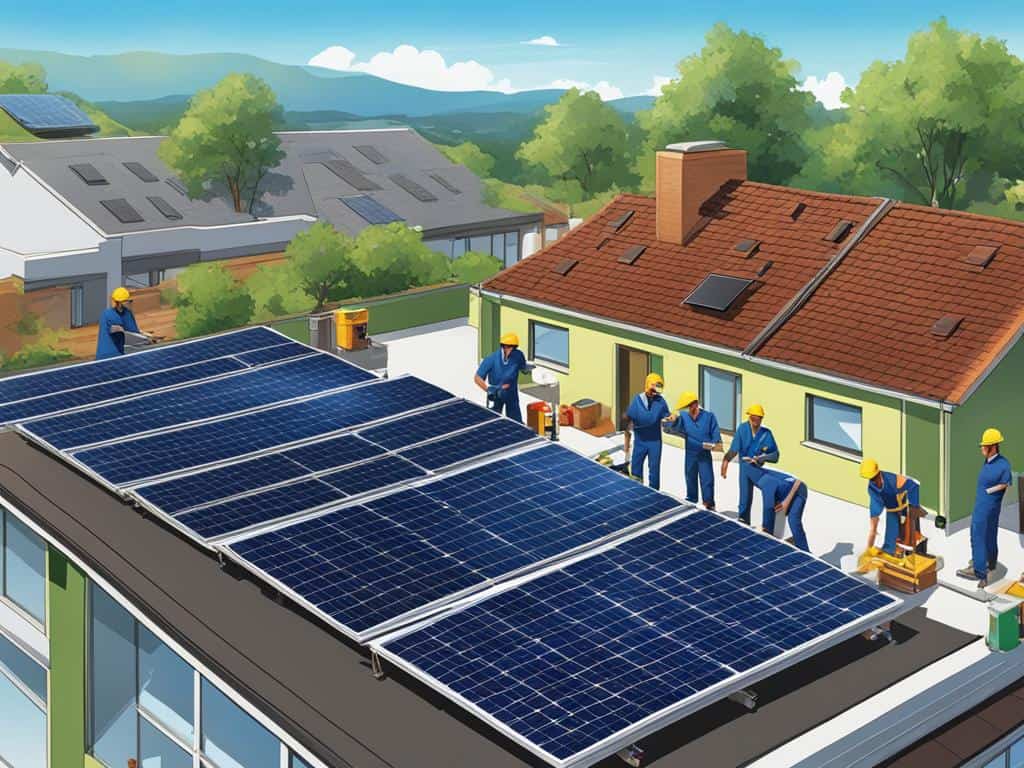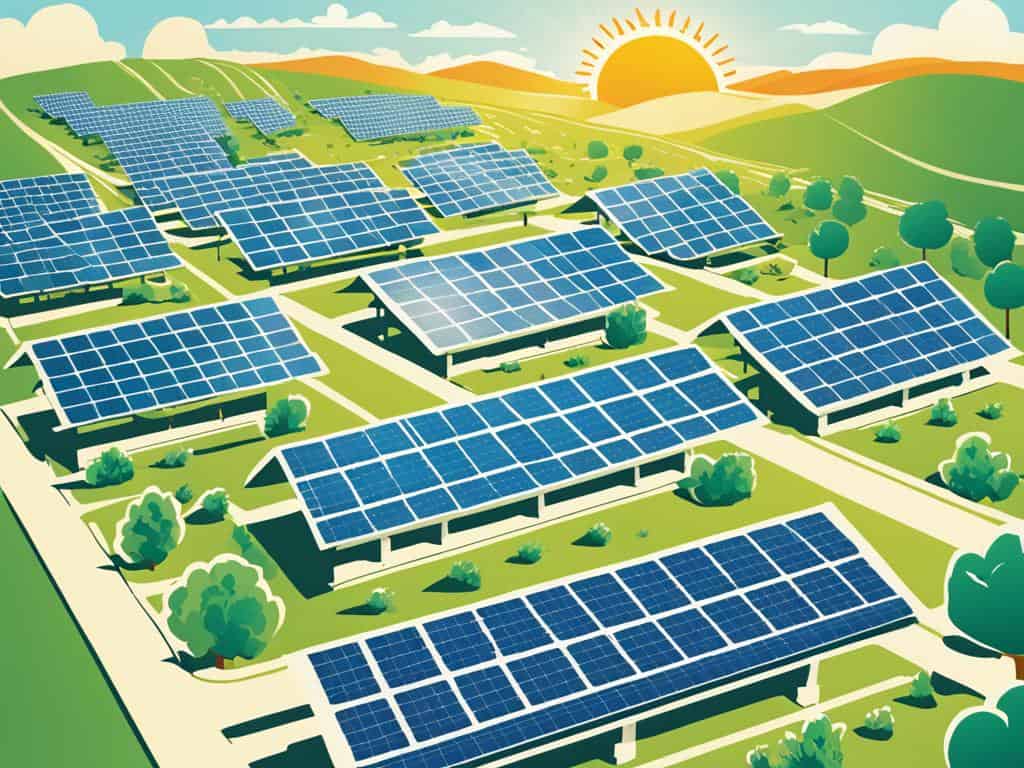Solar Plant Installation: Efficient Energy Solutions
Harness renewable energy in India with expert solar plant installation services, tailored for residential and commercial needs. Go green today!

India is moving towards a future of clean energy. The fast growth of solar panel installation services shows a global move to renewables. Solar technology stands out as both a green choice and a smart investment for homeowners. Improvements in solar efficiency, financial benefits, and lower costs make solar power system installation more appealing.
Fenice Energy leads the change with professional solar installation for over twenty years. They offer advanced, customized solutions for homes and businesses. Each solar plant installation ensures efficiency, durability, and a greener Earth.
Key Takeaways
- Decreasing costs and increasing efficiency are making solar energy investments more appealing.
- Fenice Energy’s extensive experience ensures optimal solar plant installation tailored to individual needs.
- Financial incentives like the Solar Investment Tax Credit (ITC) enhance the affordability of solar solutions.
- Solar energy systems offer the potential to increase home value, akin to major home renovations.
- Technology advancements such as perovskite solar cells are pushing the envelope of solar efficiency.
- Hybrid energy systems highlight the growing trend towards integrated renewable energy solutions.
Understanding the Essentials of Solar Plant Installation
Solar energy is leading the way in India’s renewable energy revolution. Homeowners and businesses are choosing renewable sources more and more. It’s crucial to grasp the details of solar plant installations. They don’t just convert sunlight into electricity. They also store and manage it well.
The Evolution of Solar Panel Efficiency
Solar technology has come a long way. It’s not just about putting panels on rooftops anymore. The way photovoltaic cells work and how solar panels are made have gotten much better. Now, they capture more energy from the sun per square meter than before. This is great news for everyone. It helps homeowners who don’t have much space. It also helps big companies that want to get the most out of their solar projects.
Key Components of a Solar Power System
A good solar installation has many important parts. These include photovoltaic cells that take in sunlight and structures that hold the panels up. There are also inverters that change solar energy into electricity we can use. Plus, these systems need to connect to the power grid or your home’s energy network.
Storing energy in solar power systems is complex. Many technologies help store and manage energy well. Getting the most from solar power means understanding these different storage options. They come in many sizes and types, each with its own use.

The size and power of storage facilities matter a lot. They can be small systems for homes or huge ones for big companies. This variety means there’s a storage solution for nearly any need.
Solar Energy: Tailored Solutions for Various Applications
Solar energy can work for anyone. Whether you’re a small home or a big business wanting to lower your carbon footprint, there’s a solar solution for you. Solar power can even create new fuels. Plus, falling tech costs are making solar more available to everyone.
At the core of these systems are many storage options. There’s pumped-storage hydropower for big reserves, reliable lithium-ion batteries, and even thermal storage. Each has its own benefits, fitting different needs in solar installations.
| Technology | Application | Storage Capacity | Common Use Case |
|---|---|---|---|
| Lithium-ion Batteries | Electricity Storage | Varies; suitable for residential to utility-scale | Household energy storage, electric vehicles |
| Pumped-Storage Hydropower | Large-scale Energy Reserves | MegaWatt-Hours | Utility grids, balancing supply and demand |
| Thermal Storage Systems | Heat Retention | Kilowatt-Hours to MegaWatt-Hours | Concentrated Solar Power plants |
| Flywheel Storage | Rapid Energy Discharge | Limited capacity, quick delivery | Grid stabilization, power quality |
| Compressed Air Storage | Efficient Electricity Generation | Kilowatt-Hours to MegaWatt-Hours | Utility-scale energy management |
New trends in solar power are exciting. They are changing how we store and use energy. For example, generating fuels like hydrogen and using virtual storage. These advances help lower energy use during peak times and improve energy security.
For solar energy to reach its full potential, it needs the right technology, customization, and professional work. In India, this means taking a forward-thinking approach. This benefits everyone, from homes to businesses, leading to a sustainable future.
Designing a System: The Role of Professional Solar Installation
Starting a solar power journey needs a smart plan. Experts must use precision. The 2020 Solar Jobs Census shows that 67% of solar jobs are in installation and development. Professional solar installation offers solutions that fit different needs for homes and businesses.
Customizing Solar Solutions for Residential and Commercial Needs
Custom solar plans consider local factors and energy needs. Solar companies look at climate, space, and power use. They aim to create systems that are both powerful and reliable. The best angle for solar panels in northern areas is generally true south. This helps solar panels work their best.

Good planning and expertise are key to customizing solar systems. There are many solar training programs, like the MREA Solar Ready Wisconsin Project. These programs aim to meet solar industry needs. This ensures solar installations are done by skilled professionals. Support from programs like Advancing Equity Through Workforce Partnerships helps bring diverse talents into the solar field.
The Importance of Qualified Installers in Maximizing System Performance
Top-performing systems need skilled installers. These pros have the training and certification, like NABCEP, to install solar panels right. They also evaluate sites carefully, looking at things like shade and sunlight over the year. Avoiding shade is crucial since it can drastically reduce power output.
Efforts like the PEA Bright Solar Futures train a skilled workforce. This training ensures professionals can fine-tune system performance. This benefits both residential and commercial setups. A solar company can meet the specific needs of each customer.
| Supporting Initiative | Objective | Beneficiaries |
|---|---|---|
| Safer Foundation Solar Energy Demand Skills Training Project | Provide training for the reintegration of individuals from the criminal justice system into the workforce | Formerly incarcerated individuals |
| Blue Lake Rancheria Project | Offer training and outreach to Native Americans | Native American communities |
| IGEN Project | Enhance and align solar curriculum across community colleges | Students across Illinois |
Professional solar installation plays a big role in solar systems’ success. Experts can handle challenges like cloudy days and add technology like energy storage. This makes solar a wise choice for the future. It shows how expert installation is key to solar energy’s success in homes and businesses.
Advanced tech and skilled teams lead to successful solar projects. They lay a strong foundation for clean energy. This is vital for both houses and companies wanting green power.
Financial Aspects of Solar Energy Installation in India
Strategic financial planning is key to advancing India’s renewable energy. The cost of solar panels has dropped a lot, helping India push its green agenda forward. In the last decade, the cost to install solar panels in India has dropped greatly. This is one of the biggest reductions in the world from 2010 to 2022.
The government offers financial incentives for solar installation. These help both businesses and homes start using solar energy by reducing upfront costs. This encouragement has led to more investment in clean energy.
Cost Analysis and Incentives for Installation
In 2018, India made a big achievement. The cost of solar energy became cheaper than fossil fuel energy. The government has schemes like the Solar Park Scheme and the PM-KUSUM initiative. They support solar plant installations with clear infrastructure and financial backing. The Solar Park Scheme aims to reach 40,000 MW by 2025-26, making it easier to start large-scale solar projects.
Solar power tariffs have dropped from over Rs 17 per unit to under Rs 2.5. This shows the great potential for investing in solar power. This drop is thanks to cheaper module prices from new technology and market growth, making solar more cost-effective.
Understanding Return on Investment in Solar Plants
Investing in solar energy brings financial and environmental benefits. For instance, the INR 93,041 Cr under the Production Linked Incentive scheme shows the government’s dedication to renewables. This leads to job creation and less carbon emissions. With goals like these, India is ready to lead in clean technology, create jobs, and work towards being carbon neutral.
India plans to meet half its energy needs with renewables by 2030. This will greatly reduce its carbon emissions. Because of these goals, India is attracting lots of foreign investment in solar energy, with over $14,858 Mn coming in. This is turning India into a leading solar energy hub.
India’s budget and funding models are set to create a future that’s both economically and ecologically sound.

| Parameter | 2010 | 2022 |
|---|---|---|
| Solar Module Price Reduction | 0% | 82-85% |
| Solar Power Tariff | Rs 17 per unit | Less than Rs 2.5 per unit |
| Solar Park Scheme Target | 20,000 MW | 40,000 MW |
| FDI in Solar Energy (Apr 2000-Jun 2023) | Not Applicable | $14,858 Mn |
India’s solar sector is transforming, thanks to wise financial planning and innovative policies. It’s becoming more cost-effective, attracting big investments, and promising sustainable returns.
Solar Plant Installation
The key to a good solar plant setup is doing a thorough site check. This ensures the sun’s rays are used well. India, with its strong solar power setup of 81.813 GWAC by March 31, 2024, knows this well. Preparations focus on sustainability and energy independence. They check everything, including the weather, to ensure success. India’s push for green energy is evident in its 42 solar parks. These parks make it easier for solar projects to start, showing a commitment to future clean energy efforts.
Site Assessment & Preparation for Optimal Solar Collection
Many U.S. homes can’t have rooftop solar due to renting or not enough roof space. Community solar programs are their answer. Like in India, these programs help people join forces to invest in solar. This makes moving to renewable energy faster and easier. Gujarat shines in India’s solar scene with 7,806 MW power as of June 30, 2022. Their careful planning and action highlight India’s role as a key player in solar energy.
Overcoming Common Challenges in Solar Power System Installation
Adding solar energy to the grid has challenges, like needing better batteries and following rules. Yet, creative solutions like Power Purchase Agreements (PPAs) help. They make solar affordable, so people can have solar setups by top companies. The work these companies do is vital and takes up about 10% of the cost. Experts like those from Fenice Energy are crucial. Their knowledge is especially needed when getting incentives for solar projects. With a goal of reaching 100 GW of solar power, India’s focus on clean installations is key to its energy future.
FAQ
Q: What makes solar plant installation an efficient energy solution?
A: Solar plant installation captures the sun’s power using advanced photovoltaic cells. This creates a green and cost-saving energy source. Thanks to tech advancements, solar panels now require less space for more power, increasing their appeal.
Q: How has solar panel efficiency evolved?
A: Solar panel efficiency has jumped forward with better PV cell technology. Current panels convert about 20% of sunlight into electricity. This boost means each solar panel produces more power than before.
Q: What are the key components of a solar power system?
A: A solar power system’s main parts are photovoltaic cells, supporting structures, and inverters for power conversion. It also includes connections to the grid. Effective systems control device temperature, manage light reflection, and optimize for solar intensity.
Q: How are solar energy systems tailored for different applications?
A: Solar energy setups are customized for homes and businesses. It involves picking suitable panels, the best mounting, and smart energy management. This customization ensures efficiency and performance.
Q: Why is professional solar installation important for customizing solar solutions?
A: Professional installation ensures solar systems meet specific needs. Installers assess the site, decide on the panel layout, and pick components based on climate, space, and energy needs. This approach maximizes system performance.
Q: What role do qualified installers have in the performance of solar power systems?
A: Qualified installers play a big part in solar system performance. Their planning and precision during setup ensures systems meet energy demands precisely. They make sure everything works well with the grid and energy management.
Q: What financial aspects should be considered in solar energy installation in India?
A: When setting up solar energy in India, it’s crucial to think about setup costs, quality, and incentives. Groups like Fenice Energy guide you through financial considerations. They help with subsidies, incentives from MNRE, and arranging PPAs. This helps make solar projects economically sound.
Q: How can the return on investment in solar plants be understood?
A: To understand solar investment return, think about long-term gains. These include savings on bills, higher property value, and lower carbon footprint. Also, remember the saved costs in operation and maintenance over time.
Q: What does site assessment entail for solar plant installation?
A: Site assessment checks many factors like location, sunlight, climate, and roof condition. It also looks at potential environmental impacts. This ensures the site is best suited for solar efficiency.
Q: What are common challenges in solar power system installation, and how are they overcome?
A: Solar installation faces hurdles like environmental rules, grid integration, and site issues. Solutions include using high-tech like geospatial analysis, green construction methods, and efficient energy storage.


